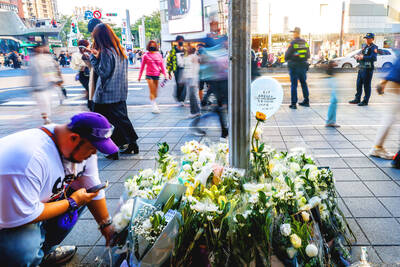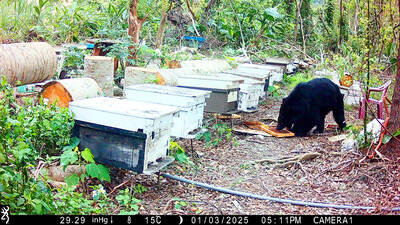An independent agency should be established to oversee the disposal of the nation’s nuclear waste, New Power Party (NPP) Legislator Huang Kuo-chang (黃國昌) said yesterday, as controversy continues over plans to store spent nuclear fuel following the decommissioning of the nation’s nuclear power plants.
“The Nuclear Materials and Radioactive Waste Management Act (放射性物料管理法) is outdated and does not reflect the necessity of allowing the public to participate in the review process,” Huang said at a public hearing at the Legislative Yuan.
His New Taipei City district is home to the Guosheng Nuclear Power Plant in Wanli District (萬里) and the site of the now-sealed Fourth Nuclear Power Plant.
“The law lacks any conception of short and medium-term temporary storage, only focusing on final storage of the materials,” Huang said.
“However, we all know that final storage will not happen for the foreseeable future and we have to think about how we are going to handle the problem in the interim,” Huang said, adding that an independent agency should be established to decide the matter according to an open review process based on objective guidelines.
Taiwan Power Co (Taipower), which operates the nuclear power plants, is left to come up with plans internally without clear legal guidelines, he said.
With the nation’s three usable nuclear plants to be decommissioned by 2025, finding a way to dispose of their spent nuclear fuel has become a pressing problem, even as the government has continued to struggle to find a new storage site for materials contaminated with “low level” radiation.
Over the past 20 years, newly contaminated material has been stored onsite at nuclear power plants, while Orchid Island (Lanyu, 蘭嶼) continues to house older waste, despite government promises to find another site.
National Taiwan Ocean University professor emeritus of applied geosciences Lee Chao-shing (李昭興) said finding a safe medium-term storage site for spent fuel and contaminated materials would be difficult given the nation’s geology.
“In Taiwan, there are approximately 30,000 earthquakes, both big and small, every year on average, while the central mountain range is being raised by between 4cm and 5cm every year,” Lee said.
“In this kind of active geological environment, looking for a medium-term storage site is a little bit like looking for fish in a tree, but that is our task,” he said.
As finding a permanent, safe storage site is likely impossible, nuclear waste should be sent for reprocessing overseas to reduce its volume before being sold to other countries as nuclear fuel, Lee said.
Taipower vice president Tsai Fuh-feng (蔡富豐) said a medium-term storage site would not be identified until 2038 according to company plans, adding that people refusing to agree to referendums on alternative sites was to blame for delays in removing waste from Orchid Island.
According to the Act on Sites for Establishment of Low Level Radioactive Waste Final Disposal Facility (低放射性廢棄物最終處置設施場址設置條例), any disposal site must be approved in a referendum by the municipality or county to house it.
“Even though we have done our best to come up with all sorts of plans and we have several possible sites, the reality is that there are already certain facts on the ground,” Tsai said, adding that legislation to establish an independent platform to come up with a consensus on how to address the issue should be prepared to provide the company with a clear legal basis for disposal plans.
The company has pushed for permission to construct “temporary” storage facilities at nuclear plants after they are decommissioned.

SHIPS, TRAINS AND AUTOMOBILES: The ministry has announced changes to varied transportation industries taking effect soon, with a number of effects for passengers Beginning next month, the post office is canceling signature upon delivery and written inquiry services for international registered small packets in accordance with the new policy of the Universal Postal Union, the Ministry of Transportation and Communications said yesterday. The new policy does not apply to packets that are to be delivered to China, the ministry said. Senders of international registered small packets would receive a NT$10 rebate on postage if the packets are sent from Jan. 1 to March 31, it added. The ministry said that three other policies are also scheduled to take effect next month. International cruise ship operators

NUMBERS IMBALANCE: More than 4 million Taiwanese have visited China this year, while only about half a million Chinese have visited here Beijing has yet to respond to Taiwan’s requests for negotiation over matters related to the recovery of cross-strait tourism, the Tourism Administration said yesterday. Taiwan’s tourism authority issued the statement after Chinese-language daily the China Times reported yesterday that the government’s policy of banning group tours to China does not stop Taiwanese from visiting the country. As of October, more than 4.2 million had traveled to China this year, exceeding last year. Beijing estimated the number of Taiwanese tourists in China could reach 4.5 million this year. By contrast, only 500,000 Chinese tourists are expected in Taiwan, the report said. The report

HORROR STORIES: One victim recounted not realizing they had been stabbed and seeing people bleeding, while another recalled breaking down in tears after fleeing A man on Friday died after he tried to fight the knife-wielding suspect who went on a stabbing spree near two of Taipei’s busiest metro stations, Taipei Mayor Chiang Wan-an (蔣萬安) said. The 57-year-old man, identified by his family name, Yu (余), encountered the suspect at Exit M7 of Taipei Main Station and immediately tried to stop him, but was fatally wounded and later died, Chiang said, calling the incident “heartbreaking.” Yu’s family would receive at least NT$5 million (US$158,584) in compensation through the Taipei Rapid Transit Corp’s (TRTC) insurance coverage, he said after convening an emergency security response meeting yesterday morning. National

The Forestry and Nature Conservation Agency yesterday launched a gift box to market honey “certified by a Formosan black bear” in appreciation of a beekeeper’s amicable interaction with a honey-thieving bear. Beekeeper Chih Ming-chen (池明鎮) in January inspected his bee farm in Hualien County’s Jhuosi Township (卓溪) and found that more than 20 beehives had been destroyed and many hives were eaten, with bear droppings and paw prints near the destroyed hives, the agency said. Chih returned to the farm to move the remaining beehives away that evening when he encountered a Formosan black bear only 20m away, the agency said. The bear